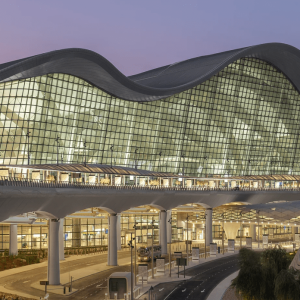A Day of Sudden Silence in the Skies
In an unexpected turn of events, Zayed International Airport in Abu Dhabi faced a temporary closure of airspace that halted dozens of flights and left thousands of passengers grounded. The closure, which lasted only a few hours, sent a ripple through the region’s aviation networks, affecting flight schedules, passenger plans, and airline operations across multiple countries.
The closure was brief but significant. Flights in and out of the UAE capital were either cancelled or rerouted as air traffic controllers received instructions to pause takeoffs and landings. While the shutdown was temporary, its impact was immediate and widespread.
As confusion rippled across terminals and departure lounges, Zayed International’s management responded swiftly with clear updates, and the airport’s operations teams moved rapidly to ensure safety protocols were followed while working to restore services.

The Closure’s Regional Impact
The incident affected more than just Abu Dhabi. Neighboring airports, including those in Dubai, Doha, and Kuwait, experienced knock-on effects. Flight delays became the norm, and airlines began issuing rolling updates to inform travelers of status changes and revised itineraries.
International flights bound for Abu Dhabi were diverted mid-route. Departures were held back in cities around the world. Airlines operating across the Gulf—including major carriers and low-cost operators—were forced to rethink their route maps in real time.

This kind of regional domino effect isn’t uncommon during an airspace closure. Given the tightly connected nature of air travel across the Gulf states, even a short disruption at a major hub like Zayed International can create a chain reaction that stretches across continents.
Fast, Focused Response by Airport and Airlines
Zayed International Airport quickly issued an urgent update across all official channels, informing passengers of the closure and encouraging them to check with their airlines before heading to the airport. Real-time coordination between air traffic control, ground operations, and airline partners helped prevent further disruption.
Etihad Airways, based at Zayed International, acted immediately to provide customer service support, rebooking assistance, and priority care for stranded travelers. Other carriers, including Wizz Air Abu Dhabi and Air Arabia, adjusted their schedules in real time, offering refunds, rebookings, and travel credit options for affected customers.
Airport staff were deployed across terminals to assist, calm, and redirect passengers. Travellers reported clear communication from the airline counters, with real-time displays keeping everyone updated on the situation.
Despite the initial uncertainty, the airport maintained calm, and the emphasis remained firmly on passenger wellbeing.
Flights Resume, But the Airspace Puzzle Isn’t Over Yet
By the early hours of the following morning, airspace over the UAE had officially reopened. Aircraft slowly returned to the skies, and Zayed International ramped up operations steadily. However, recovery from such an event isn’t instant.

Even with airspace open, flight schedules require hours—sometimes days—to normalise. Flights missed their slots, aircraft needed repositioning, and ground crews faced a backlog of work. Nevertheless, the airport’s operational teams handled the transition with remarkable efficiency.
Flight trackers showed planes steadily landing and taking off once more. Passengers began to breathe easier. For those whose trips were delayed or disrupted, the worst was over, but the ripple effect continued across airline networks for some time.
Emotional Toll on Travellers
For many passengers, the sudden halt in their travel plans was more than an inconvenience—it was a deeply stressful experience. Families en route to reunions, business travellers racing against deadlines, and tourists on tight itineraries were all affected.
One traveller, stuck overnight in the departure lounge, described the experience as “confusing at first but reassuring once the airport staff started distributing updates and offering water, snacks, and even hotel vouchers.”
Another remarked, “These things happen, but the way they handled it here made all the difference. It felt like we were being looked after.”
This human element often gets lost in stories about airspace closures, but it’s at the heart of air travel. Behind every delayed flight are people with stories, expectations, and hopes. How airports and airlines respond in those moments defines their reputation—and Zayed International rose to the occasion.
Why the Closure Happened
While officials did not offer in-depth public statements on the precise cause, it’s clear that the decision was driven by precaution. Regional tensions had escalated in recent days, and governments acted to protect their skies, aircraft, and citizens.
The airspace closure was not due to mechanical failure, weather, or airport infrastructure—it was a strategic, safety-first call. And given how quickly it was lifted, it’s evident that the risk was temporary and well-managed.
Air traffic in the region is among the busiest in the world, and even a short pause has wide implications. Yet despite the complexities, the closure was handled with clarity and speed.
What’s Next for Zayed International
Even as operations return to normal, the airport continues to monitor the skies closely. Flight schedules will remain flexible over the coming days, with some ongoing delays and reroutes possible as air traffic control and airlines adjust.
Authorities have reassured passengers that the situation is stable, with no immediate concerns requiring additional closures. The UAE’s aviation infrastructure is robust, and Zayed International has demonstrated its capability to adapt under pressure.
Looking ahead, travellers are encouraged to keep an eye on travel advisories, sign up for flight notifications, and arrive at the airport earlier than usual during high-alert periods.
The Bigger Picture: Safety Over Speed
This incident highlights a broader truth about aviation: safety always takes precedence. While the disruption affected thousands, it also showcased the aviation industry’s ability to prioritise human life over efficiency.

Airports like Zayed International are not just transportation hubs—they are complex ecosystems requiring real-time coordination, leadership, and trust. The fact that the closure was handled quickly, professionally, and with clear communication is a win for both the airport and its passengers.
Final Thoughts: A Challenge Met With Confidence
The unexpected airspace closure at Zayed International Airport tested the resilience of Abu Dhabi’s aviation system—and it passed that test with flying colours. Through quick decisions, empathetic service, and transparent updates, the airport reaffirmed its place as one of the most trusted in the world.
For passengers, the memory of the closure may linger briefly. But what will stay longer is the sense of care, clarity, and confidence that Zayed International provided during a moment of uncertainty.
In the skies and on the ground, Abu Dhabi’s airport proved that when the unexpected happens, excellence in service and safety remains the first priority.
Do follow UAE Stories on Instagram
Read More: UAE Wound Wash Market Size, Share & Trends Analysis Report and Competitive Analysis, 2025-2030














